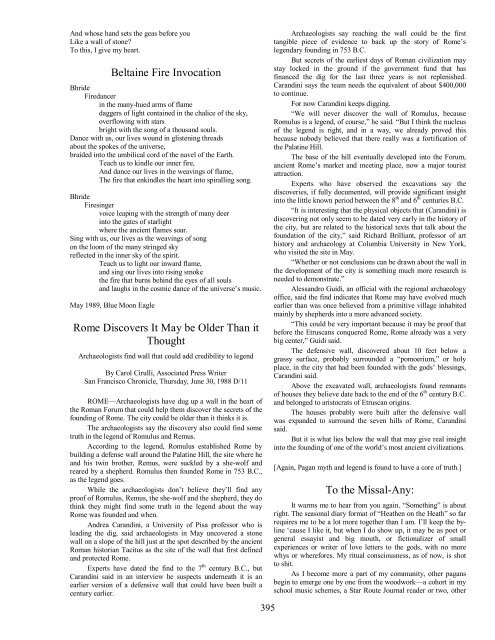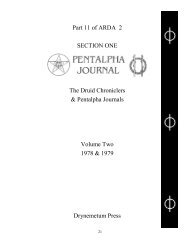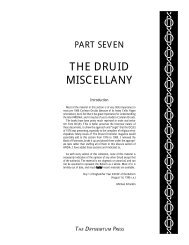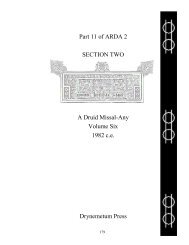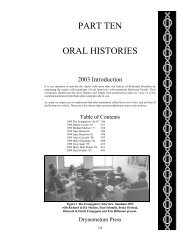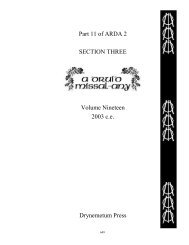Part 11 of ARDA 2 SECTION TWO A - Student Organizations ...
Part 11 of ARDA 2 SECTION TWO A - Student Organizations ...
Part 11 of ARDA 2 SECTION TWO A - Student Organizations ...
Create successful ePaper yourself
Turn your PDF publications into a flip-book with our unique Google optimized e-Paper software.
And whose hand sets the geas before you<br />
Like a wall <strong>of</strong> stone<br />
To this, I give my heart.<br />
Beltaine Fire Invocation<br />
Bhride<br />
Firedancer<br />
in the many-hued arms <strong>of</strong> flame<br />
daggers <strong>of</strong> light contained in the chalice <strong>of</strong> the sky,<br />
overflowing with stars<br />
bright with the song <strong>of</strong> a thousand souls.<br />
Dance with us, our lives wound in glistening threads<br />
about the spokes <strong>of</strong> the universe,<br />
braided into the umbilical cord <strong>of</strong> the navel <strong>of</strong> the Earth.<br />
Teach us to kindle our inner fire,<br />
And dance our lives in the weavings <strong>of</strong> flame,<br />
The fire that enkindles the heart into spiralling song.<br />
Bhride<br />
Firesinger<br />
voice leaping with the strength <strong>of</strong> many deer<br />
into the gates <strong>of</strong> starlight<br />
where the ancient flames soar.<br />
Sing with us, our lives as the weavings <strong>of</strong> song<br />
on the loom <strong>of</strong> the many stringed sky<br />
reflected in the inner sky <strong>of</strong> the spirit.<br />
Teach us to light our inward flame,<br />
and sing our lives into rising smoke<br />
the fire that burns behind the eyes <strong>of</strong> all souls<br />
and laughs in the cosmic dance <strong>of</strong> the universe’s music.<br />
May 1989, Blue Moon Eagle<br />
Rome Discovers It May be Older Than it<br />
Thought<br />
Archaeologists find wall that could add credibility to legend<br />
By Carol Cirulli, Associated Press Writer<br />
San Francisco Chronicle, Thursday, June 30, 1988 D/<strong>11</strong><br />
ROME—Archaeologists have dug up a wall in the heart <strong>of</strong><br />
the Roman Forum that could help them discover the secrets <strong>of</strong> the<br />
founding <strong>of</strong> Rome. The city could be older than it thinks it is.<br />
The archaeologists say the discovery also could find some<br />
truth in the legend <strong>of</strong> Romulus and Remus.<br />
According to the legend, Romulus established Rome by<br />
building a defense wall around the Palatine Hill, the site where he<br />
and his twin brother, Remus, were suckled by a she-wolf and<br />
reared by a shepherd. Romulus then founded Rome in 753 B.C.,<br />
as the legend goes.<br />
While the archaeologists don’t believe they’ll find any<br />
pro<strong>of</strong> <strong>of</strong> Romulus, Remus, the she-wolf and the shepherd, they do<br />
think they might find some truth in the legend about the way<br />
Rome was founded and when.<br />
Andrea Carandini, a University <strong>of</strong> Pisa pr<strong>of</strong>essor who is<br />
leading the dig, said archaeologists in May uncovered a stone<br />
wall on a slope <strong>of</strong> the hill just at the spot described by the ancient<br />
Roman historian Tacitus as the site <strong>of</strong> the wall that first defined<br />
and protected Rome.<br />
Experts have dated the find to the 7 th century B.C., but<br />
Carandini said in an interview he suspects underneath it is an<br />
earlier version <strong>of</strong> a defensive wall that could have been built a<br />
century earlier.<br />
395<br />
Archaeologists say reaching the wall could be the first<br />
tangible piece <strong>of</strong> evidence to back up the story <strong>of</strong> Rome’s<br />
legendary founding in 753 B.C.<br />
But secrets <strong>of</strong> the earliest days <strong>of</strong> Roman civilization may<br />
stay locked in the ground if the government fund that has<br />
financed the dig for the last three years is not replenished.<br />
Carandini says the team needs the equivalent <strong>of</strong> about $400,000<br />
to continue.<br />
For now Carandini keeps digging.<br />
“We will never discover the wall <strong>of</strong> Romulus, because<br />
Romulus is a legend, <strong>of</strong> course,” he said. “But I think the nucleus<br />
<strong>of</strong> the legend is right, and in a way, we already proved this<br />
because nobody believed that there really was a fortification <strong>of</strong><br />
the Palatine Hill.<br />
The base <strong>of</strong> the hill eventually developed into the Forum,<br />
ancient Rome’s market and meeting place, now a major tourist<br />
attraction.<br />
Experts who have observed the excavations say the<br />
discoveries, if fully documented, will provide significant insight<br />
into the little known period between the 8 th and 6 th centuries B.C.<br />
“It is interesting that the physical objects that (Carandini) is<br />
discovering not only seem to be dated very early in the history <strong>of</strong><br />
the city, but are related to the historical texts that talk about the<br />
foundation <strong>of</strong> the city,” said Richard Brilliant, pr<strong>of</strong>essor <strong>of</strong> art<br />
history and archaeology at Columbia University in New York,<br />
who visited the site in May.<br />
“Whether or not conclusions can be drawn about the wall in<br />
the development <strong>of</strong> the city is something much more research is<br />
needed to demonstrate.”<br />
Alessandro Guidi, an <strong>of</strong>ficial with the regional archaeology<br />
<strong>of</strong>fice, said the find indicates that Rome may have evolved much<br />
earlier than was once believed from a primitive village inhabited<br />
mainly by shepherds into a more advanced society.<br />
“This could be very important because it may be pro<strong>of</strong> that<br />
before the Etruscans conquered Rome, Rome already was a very<br />
big center,” Guidi said.<br />
The defensive wall, discovered about 10 feet below a<br />
grassy surface, probably surrounded a “pomoerium,” or holy<br />
place, in the city that had been founded with the gods’ blessings,<br />
Carandini said.<br />
Above the excavated wall, archaeologists found remnants<br />
<strong>of</strong> houses they believe date back to the end <strong>of</strong> the 6 th century B.C.<br />
and belonged to aristocrats <strong>of</strong> Etruscan origins.<br />
The houses probably were built after the defensive wall<br />
was expanded to surround the seven hills <strong>of</strong> Rome, Carandini<br />
said.<br />
But it is what lies below the wall that may give real insight<br />
into the founding <strong>of</strong> one <strong>of</strong> the world’s most ancient civilizations.<br />
[Again, Pagan myth and legend is found to have a core <strong>of</strong> truth.]<br />
To the Missal-Any:<br />
It warms me to hear from you again. “Something” is about<br />
right. The seasonal diary format <strong>of</strong> “Heathen on the Heath” so far<br />
requires me to be a lot more together than I am. I’ll keep the byline<br />
‘cause I like it, but when I do show up, it may be as poet or<br />
general essayist and big mouth, or fictionalizer <strong>of</strong> small<br />
experiences or writer <strong>of</strong> love letters to the gods, with no more<br />
whys or wherefores. My ritual consciousness, as <strong>of</strong> now, is shot<br />
to shit.<br />
As I become more a part <strong>of</strong> my community, other pagans<br />
begin to emerge one by one from the woodwork—a cohort in my<br />
school music schemes, a Star Route Journal reader or two, other


